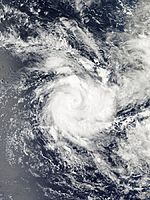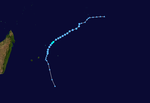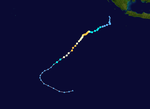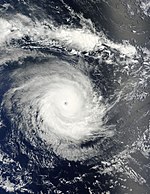2014–15 South-West Indian Ocean cyclone season
| 2014–15 South-West Indian Ocean cyclone season | |
|---|---|
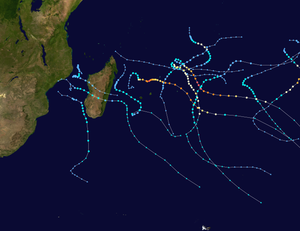 Season summary map | |
| Seasonal boundaries | |
| First system formed | November 16, 2014 |
| Last system dissipated | Currently active |
| Strongest storm | |
| Name | Eunice |
| • Maximum winds | 240 km/h (150 mph) (10-minute sustained) |
| • Lowest pressure | 900 hPa (mbar) |
| Seasonal statistics | |
| Total disturbances | 8 |
| Total depressions | 6 |
| Total storms | 6 |
| Tropical cyclones | 3 |
| Intense tropical cyclones | 3 |
| Very intense tropical cyclones | 2 |
| Total fatalities | 293 |
| Total damage | ~ $300 million (2015 USD) |
| Related articles | |
The 2014–15 South-West Indian Ocean cyclone season is an ongoing event of the annual cycle of tropical cyclone and subtropical cyclone formation. It began on November 15, 2014, and will end on April 30, 2015, with the exception for Mauritius and the Seychelles, for which it will end on May 15, 2015. These dates conventionally delimit the period of each year when most tropical and subtropical cyclones form in the basin, which is west of 90°E and south of the Equator. Tropical and subtropical cyclones in this basin are monitored by the Regional Specialised Meteorological Centre in Réunion.
Seasonal summary

During October 2014, the Mauritius Meteorological Services issued its seasonal outlook for the summer of 2014–15 and predicted that between ten to twelve named storm would develop during the season.[1] The first tropical disturbance of the season developed on November 16, and quickly developed into the first named storm of the season and was named Adjali by Mauritius.
Storms
Severe Tropical Storm Adjali
| Severe tropical storm (MFR) | |
| Category 1 tropical cyclone (SSHWS) | |
| Duration | November 16 – November 23 |
|---|---|
| Peak intensity | 100 km/h (65 mph) (10-min); 986 hPa (mbar) |
An area of low pressure developed close to Diego Garcia on November 14. It slowly organized as it made a northwest-south-southeast loop over the next two days. By the evening of November 16, the center of the storm became more well defined with convective rainbands wrapped tightly into it.[2] Around that time, RSMC La Réunion started tracking the system as a tropical disturbance,[3] and subsequently upgraded it to a Tropical Depression.[4] Later that day, the JTWC issued a tropical cyclone formation alert on the system.[5] The depression strengthened further and became the first named tropical storm of the year, on the same day. Mauritius Meteorological Service, which usually names storms in the region, named the system Adjali.[6] The JTWC also initiated advisories on Adjali.[7] On November 17, MFR upgraded it to a Severe Tropical Storm.[8] On November 20, Adjali turned west until reached the northern tip of Madagascar on November 23 and rapidly dissipated.
Tropical Depression 02
| Tropical depression (MFR) | |
| Tropical storm (SSHWS) | |
| Duration | November 25 – November 30 |
|---|---|
| Peak intensity | 55 km/h (35 mph) (10-min); 997 hPa (mbar) |
During November 25, RSMC La Reunion reported that Tropical Disturbance 2, had developed within a marginal environment for further development to the northeast of the Mascarene islands.[9] During that day despite having a low-level circulation centre that was located to the east of the deepest atmospheric convection, the system developed into a tropical depression. The depression continued to intensified as it was classified as a tropical storm by the JTWC early on November 27. The next day, the system moved in a southwestward direction and cooler waters. With this, the JTWC downgraded it to a tropical depression again on November 29, without the MFR upgrading it to a tropical storm.
Intense Tropical Cyclone Kate
| Intense tropical cyclone (MFR) | |
| Category 3 tropical cyclone (SSHWS) | |
| Duration | December 30 (Entered basin) – January 3 |
|---|---|
| Peak intensity | 175 km/h (110 mph) (10-min); 947 hPa (mbar) |
During December 30, Severe Tropical Cyclone Kate moved into the basin from the Australian region, where it was immediately classified as an intense tropical cyclone with 10-minute sustained wind speeds of 175 km/h (110 mph) by RSMC La Reunion.[10][11] Over the next day the system rapidly weakened into a tropical storm as it moved into an unfavourable environment for development, before RSMC La Reunion and the JTWC issued their final advisories on the system during December 31. however, the remnants of Kate continued moving southwest. as the result on January 2, the southwest wind flow, associated with Kate, dissipated and later scooped. it later scooped the eye caused to dissipated, as the remnants of Kate dissipated completely on January 3.
Very Intense Tropical Cyclone Bansi
| Very intense tropical cyclone (MFR) | |
| Category 5 tropical cyclone (SSHWS) | |
| Duration | January 9 – January 18 |
|---|---|
| Peak intensity | 220 km/h (140 mph) (10-min); 923 hPa (mbar) |
On January 9, the MFR upgraded a low-pressure system east of Madagascar to a zone of disturbed weather, and the system became a tropical disturbance late on the next day.[12][13] On January 11, the MFR upgraded the system to a tropical depression. Later that day, it intensified into a moderate tropical storm, receiving the name Bansi, whist the JTWC upgraded it to a tropical storm. In the next day, the MFR upgraded Bansi to a tropical cyclone, as the system formed a ragged eye.[14][15][16] On January 13, Bansi explosively intensified into a Category 5 cyclone. However, it soon weakened to a Category 2 on the SSHWS (intense tropical cyclone for MFR)[17] due to an eyewall replacement cycle.[17] It re-intensified slowly to a Category 4 on the SSHWS[17] as it moved East-Southeast until 13 January. Then it slowly curved Southeast and impacted Rodrigues [17] on 14 January as it had winds of 225 km/h.[17] Luckily, it passed 150 km from the island [17] and even though the cyclone's eye was 100 km wide, [17] the mean wind speed in Rodrigues was "only" of 150 km/h[17] with about 215 to 225 km/h gusts. From this moment onwards it started weakening gradually at first, but then deteriorated quickly.[17][18] On January 16, Bansi began to undergo an extratropical transition.[17] Consequently, the MFR and JTWC issued Bansi's final warning, as Bansi was absorbed by an extratropical cyclone to the northeast.
Severe Tropical Storm Chedza
| Severe tropical storm (MFR) | |
| Tropical storm (SSHWS) | |
| Duration | January 14 – January 19 |
|---|---|
| Peak intensity | 100 km/h (65 mph) (10-min); 975 hPa (mbar) |
On January 11, the JTWC started to monitor a weak tropical disturbance inland over Mozambique.
Moderate Tropical Storm Diamondra
| Moderate tropical storm (MFR) | |
| Tropical storm (SSHWS) | |
| Duration | January 26 – February 1 |
|---|---|
| Peak intensity | 85 km/h (50 mph) (10-min); 986 hPa (mbar) |
On January 26, a tropical low formed west-southeast of Mauritius. It slowly moved towards it, before the MFR upgraded the low into a zone of disturbed weather. Later that day, the area of disturbed weather intensified into a depression, as the MFR and JTWC issued their initial advisories, and designated it as 08S. On January 27, MFR reported that Tropical Depression 08S intensified into a moderate tropical storm, and so was issued the name Diamondra. Later that day, Diamondra continued to strengthen, and late on January 28, Diamondra reached moderate tropical storm intensity. Diamondra weakened, after moving over cooler waters. Late on January 29, Diamondra continued to weaken, so JTWC issued Diamondra's final warning. On January 30, Diamondra began to undergo an extratropical transition. Two days later, it was reported that Diamondra had became extratropical, and MFR announced their final advisory on the system soon after. as Diamondra dissipated on February 1.
Very Intense Tropical Cyclone Eunice
| Very intense tropical cyclone (MFR) | |
| Category 5 tropical cyclone (SSHWS) | |
| Duration | January 27 – Currently active |
|---|---|
| Peak intensity | 240 km/h (150 mph) (10-min); 900 hPa (mbar) |
On January 27, RSMC La Reunion reported that Tropical Disturbance 08, had developed to the northeast of Mauritius.[19] Later that day, the JTWC issued its initial warnings and designated it as 09S. On January 28, MFR reported that Tropical Depression 09S intensified into a moderate tropical storm, as MFR named it Eunice. Then Eunice moved from north to southeast, before Eunice intensified into a severe tropical storm, according to MFR. The JTWC upgraded Eunice into a Category 2 tropical cyclone, while the MFR upgraded Eunice to a tropical cyclone. After a period of rapid intensification, Eunice was classified as a very intense tropical cyclone by the MFR and a Category 5-equivalent tropical cyclone by the JTWC. Later the same day, Eunice became the strongest tropical cyclone within the basin in terms of 10-minute sustained winds and the third-most-intense in terms of minimum pressure. The system subsequently weakened into an intense tropical cyclone, during the next day as it underwent an eyewall replacement cycle.
Other systems
Early on December 13, Tropical Cyclone Bakung moved into the basin from the Australian region as a Category 1 tropical cyclone on the Australian tropical cyclone intensity scale.[20][21] However, during that day the system's low-level circulation centre became exposed and displaced about 280 km (175 mi)* from the deep convection.[20][22] As a result TCWC Jakarta and the JTWC issued their final warnings on the system, while RSMC La Reunion declared it to be a remnant low in their first and only warning on the system.[21][22][23]
Storm names
Within the South-West Indian Ocean, tropical depressions and subtropical depressions that are judged to have 10-minute sustained windspeeds of 65 km/h, (40 mph) by the Regional Specialized Meteorological Center on La Réunion Island, France (RSMC La Réunion) are usually assigned a name. However, it is the Sub-Regional Tropical Cyclone Advisory Centers in Mauritius and Madagascar who name the systems. The Sub-Regional Tropical Cyclone Advisory Center in Mauritius names the storm should it intensify into a moderate tropical storm between 55°E and 90°E, if the storm should intensify into a moderate tropical storm between 30°E and 55°E then the Sub-Regional Tropical Cyclone Advisory Center in Madagascar assigns the appropriate name to the storm. New name lists are used every year, while a name is normally only used once so there are currently no names are retired.[24]
|
|
|
Seasonal effects
| Name | Dates | Peak intensity | Areas affected | Damage (USD) |
Deaths | Refs | ||
|---|---|---|---|---|---|---|---|---|
| Category | Wind speed | Pressure | ||||||
| Adjali | November 16 – 23 | Severe tropical storm | 100 km/h (65 mph) | 986 hPa (29.12 inHg) | Madagascar | Minimal | None | |
| 02 | November 25 – 30 | Tropical depression | 55 km/h (35 mph) | 997 hPa (29.44 inHg) | None | None | None | |
| Bakung | December 13 | Remnant low | 35 km/h (25 mph) | 1004 hPa (29.65 inHg) | None | None | None | |
| Kate | December 30 – January 2 | Intense tropical cyclone | 175 km/h (110 mph) | 947 hPa (27.96 inHg) | None | None | None | |
| Bansi | January 9 – 18 | Very intense tropical cyclone | 220 km/h (140 mph) | 923 hPa (27.25 inHg) | Réunion, Mauritius, Rodrigues | Minimal | None | |
| Chedza | January 14 – 19 | Severe tropical storm | 100 km/h (65 mph) | 975 hPa (28.79 inHg) | Malawi, Mozambique, Madagascar | At least $300 million | 293 | [25][26] |
| Diamondra | January 26 – February 1 | Moderate tropical storm | 85 km/h (50 mph) | 986 hPa (29.12 inHg) | None | None | None | |
| Eunice | January 27 – Currently active | Very intense tropical cyclone | 240 km/h (150 mph) | 900 hPa (26.58 inHg) | None | None | None | |
| Season aggregates | ||||||||
| 8 systems | November 16 – Currently active | 240 km/h (150 mph) | 900 hPa (26.58 inHg) | At least $300 million | 293 | |||
See also
- List of Southern Hemisphere cyclone seasons
- Atlantic hurricane seasons: 2014, 2015
- Pacific hurricane seasons: 2014, 2015
- Pacific typhoon seasons: 2014, 2015
- North Indian Ocean cyclone seasons: 2014, 2015
- 2014–15 Australian region cyclone season
- 2014–15 South Pacific cyclone season
References
- ^ "Summer 2014–2015 Outlook for Mauritius and Rodrigues". Mauritius Meteorological Services. October 10, 2014. Archived from the original on October 15, 2014. Retrieved October 15, 2014.
- ^ "HIGH from ABIO10". Joint Typhoon Warning Center (JTWC). Retrieved 16 November 2014.
- ^ "Warning 001 for Tropical Disturbance 01". RSMC La Réunion. Retrieved 16 November 2014.
- ^ "Warning 002 for Tropical Depression 01". RSMC La Réunion. Retrieved 16 November 2014.
- ^ "TCFA for Tropical Depression 01". JTWC. Retrieved 16 November 2014.
- ^ "Mauritius Meteorological Services - Naming Cyclone Adjali". Mauritius Meteorological Services. Retrieved 17 November 2014.
- ^ "JTWC Cyclone Warning 001 on Cyclone Adjali". JTWC. Retrieved 17 November 2014.
- ^ "RSMC Cyclone Warning 005 on Cyclone Adjali". RSMC La Réunion. Retrieved 17 November 2014.
- ^ RSMC La Reunion Tropical Cyclone Center (November 25, 2014). Tropical Cyclone Forecast Warning 25 November 2014 05:59 UTC (Report). Météo-France. Archived from the original (PDF) on 1 January 2015. Retrieved January 24, 2015.
- ^ Western Australian Regional Office (1 January 2015). Severe Tropical Cyclone Kate (Report). Australian Bureau of Meteorology. Archived from the original on 1 January 2015. Retrieved 1 January 2015.
{{cite report}}: Unknown parameter|deadurl=ignored (|url-status=suggested) (help) - ^ RSMC La Reunion Tropical Cyclone Center (December 30, 2014). Tropical Cyclone Forecast Warning December 30, 2014 06:49 UTC (Report). Météo-France. Archived from the original (PDF) on December 30, 2014. Retrieved January 30, 2015.
{{cite report}}: Unknown parameter|deadurl=ignored (|url-status=suggested) (help) - ^ "Tropical Cyclone Forecast Warning 1/5/20142015". RSMC La Réunion. Archived from the original on 9 January 2015. Retrieved 11 January 2015.
- ^ "Tropical Cyclone Forecast Warning 4/5/20142015". RSMC La Réunion. Archived from the original on 10 January 2015. Retrieved 11 January 2015.
- ^ "Tropical Cyclone Forecast Warning 5/5/20142015". RSMC La Réunion. Archived from the original on 11 January 2015. Retrieved 11 January 2015.
- ^ "Warning Of Moderate Tropical Storm 'Bansi'". Mauritius Meteorological Services. Archived from the original on 11 January 2015. Retrieved 11 January 2015.
- ^ "Tropical Cyclone Forecast Warning 8/5/20142015". RSMC La Réunion. Archived from the original on 11 January 2015. Retrieved 11 January 2015.
- ^ a b c d e f g h i j http://moipaulderand.blog4ever.com/sw-indian-ocean-tropical-cyclones-15102014
- ^ http://www.zinfos974.com/Ex-Chedza-frappe-Madagascar-et-continue-de-se-rapprocher_a80466.html
- ^ RSMC La Reunion Tropical Cyclone Center (January 27, 2015). Tropical Cyclone Forecast Warning January 27, 2015 06:51 UTC (Report). Météo-France. Archived from the original (PDF) on January 27, 2015. Retrieved January 31, 2015.
{{cite report}}: Unknown parameter|deadurl=ignored (|url-status=suggested) (help) - ^ a b RSMC La Reunion Tropical Cyclone Center (13 December 2014). Bulletin for Cyclonic Activity and Significant Tropical Weather in the Southwest Indian Ocean 13 December 2014 12:06 UTC (Report). Météo-France. Archived from the original (PDF) on 1 January. Retrieved 1 January 2015.
{{cite report}}: Check date values in:|archivedate=(help) - ^ a b Jakarta Tropical Cyclone Warning Centre (13 December 2014). "Ocean Gale and Storm Warning 13 December 2014 02:02 UTC". Indonesian Agency for Meteorology, Climatology and Geophysics. Archived from the original on 1 January 2015. Retrieved 1 January 2015.
- ^ a b RSMC La Reunion Tropical Cyclone Center (13 December 2014). Tropical Cyclone Forecast Warning 13 December 2014 05:59 UTC (Report). Météo-France. Archived from the original on 1 January 2015. Retrieved 1 January 2015.
- ^ Joint Typhoon Warning Center. "Tropical Cyclone 03S (Bakung) Warning 13 December 2014 09:00z". United States Navy, United States Airforce. Archived from the original on 19 December 2014. Retrieved 1 January 2015.
- ^ Regional Association I Tropical Cyclone Committee (2010). "Tropical Cyclone Operational Plan for the South-West Indian Ocean" (PDF). World Meteorological Organization. Retrieved 2012-06-07.
- ^ "Flood death toll across Southern Africa reaches 260". Chicago Tribune. Retrieved 21 January 2015.
- ^ "Madagascar tropical storm claims 46 lives". Yahoo News! via AP. Retrieved 21 January 2015.

